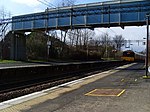Cochno Stone

The Cochno Stone is a large cup and ring marked rock at Auchnacraig, Faifley, West Dunbartonshire, Scotland, next to the Cochno farm. It is also known variously as "Whitehill 1": 9 and "the Druid Stone".: 2 The Bronze Age rock art is found on a stone measuring 42 by 26 feet (12.8 by 7.9 metres), and was documented in 1887 by the Rev. James Harvey.: 3 It features around 90 carved indentations, considered to be one of the finest sets of petroglyphs in Scotland.The stone was reburied in 1965 to protect it against vandalism. In 2015 it was partially re-exposed for investigation during a 3-day dig by a team involving archaeologists from the University of Glasgow, with a more complete re-exposure following a year later.
Excerpt from the Wikipedia article Cochno Stone (License: CC BY-SA 3.0, Authors, Images).Cochno Stone
Cochno Road,
Geographical coordinates (GPS) Address External links Nearby Places Show on map
Geographical coordinates (GPS)
| Latitude | Longitude |
|---|---|
| N 55.934682 ° | E -4.395705 ° |
Address
Cochno Stone
Cochno Road
G81 5QW
Scotland, United Kingdom
Open on Google Maps







